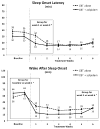Speed and trajectory of changes of insomnia symptoms during acute treatment with cognitive-behavioral therapy, singly and combined with medication
- PMID: 24831251
- PMCID: PMC4130158
- DOI: 10.1016/j.sleep.2014.02.004
Speed and trajectory of changes of insomnia symptoms during acute treatment with cognitive-behavioral therapy, singly and combined with medication
Abstract
Objectives: To examine the speed and trajectory of changes in sleep/wake parameters during short-term treatment of insomnia with cognitive-behavioral therapy (CBT) alone versus CBT combined with medication; and to explore the relationship between early treatment response and post-treatment recovery status.
Methods: Participants were 160 adults with insomnia (mean age, 50.3 years; 97 women, 63 men) who underwent a six-week course of CBT, singly or combined with 10 mg zolpidem nightly. The main dependent variables were sleep onset latency, wake after sleep onset, total sleep time, sleep efficiency, and sleep quality, derived from sleep diaries completed daily by patients throughout the course of treatment.
Results: Participants treated with CBT plus medication exhibited faster sleep improvements as evidenced by the first week of treatment compared to those receiving CBT alone. Optimal sleep improvement was reached on average after only one week for the combined treatment compared to two to three weeks for CBT alone. Early treatment response did not reliably predict post-treatment recovery status.
Conclusions: Adding medication to CBT produces faster sleep improvement than CBT alone. However, the magnitude of early treatment response is not predictive of final response after the six-week therapy. Additional research is needed to examine mechanisms involved in this early treatment augmentation effect and its impact on long-term outcome.
Keywords: Cognitive–behavioral therapy; Combined therapy; Insomnia; Medication; Sleep; Treatment response.
Copyright © 2014 Elsevier B.V. All rights reserved.
Conflict of interest statement
None declared.
Figures



Similar articles
-
Cognitive-behavior therapy singly and combined with medication for persistent insomnia: Impact on psychological and daytime functioning.Behav Res Ther. 2016 Dec;87:109-116. doi: 10.1016/j.brat.2016.09.002. Epub 2016 Sep 13. Behav Res Ther. 2016. PMID: 27658218 Free PMC article. Clinical Trial.
-
Cognitive behavioral therapy, singly and combined with medication, for persistent insomnia: a randomized controlled trial.JAMA. 2009 May 20;301(19):2005-15. doi: 10.1001/jama.2009.682. JAMA. 2009. PMID: 19454639 Free PMC article. Clinical Trial.
-
Long-Term Maintenance of Therapeutic Gains Associated With Cognitive-Behavioral Therapy for Insomnia Delivered Alone or Combined With Zolpidem.Sleep. 2017 Mar 1;40(3):zsx002. doi: 10.1093/sleep/zsx002. Sleep. 2017. PMID: 28364426 Free PMC article. Clinical Trial.
-
Psychological treatment for insomnia in the regulation of long-term hypnotic drug use.Health Technol Assess. 2004 Feb;8(8):iii-iv, 1-68. doi: 10.3310/hta8080. Health Technol Assess. 2004. PMID: 14960254 Review.
-
A new sublingual formulation of zolpidem for the treatment of sleep-onset insomnia.Expert Rev Neurother. 2012 Feb;12(2):141-53. doi: 10.1586/ern.11.197. Expert Rev Neurother. 2012. PMID: 22288669 Review.
Cited by
-
Analysis of the Improvement Sequence in Insomnia Symptoms and Factors Influencing the Treatment Outcomes of Smartphone-Delivered CBT in Patients with Insomnia Disorder.Nat Sci Sleep. 2024 Sep 13;16:1365-1376. doi: 10.2147/NSS.S486288. eCollection 2024. Nat Sci Sleep. 2024. PMID: 39290809 Free PMC article.
-
Patience required: increasing sleep duration in the months to years following CBT-I.J Clin Sleep Med. 2022 Jul 1;18(7):1729-1730. doi: 10.5664/jcsm.10044. J Clin Sleep Med. 2022. PMID: 35481426 Free PMC article. No abstract available.
-
Cognitive-behavior therapy singly and combined with medication for persistent insomnia: Impact on psychological and daytime functioning.Behav Res Ther. 2016 Dec;87:109-116. doi: 10.1016/j.brat.2016.09.002. Epub 2016 Sep 13. Behav Res Ther. 2016. PMID: 27658218 Free PMC article. Clinical Trial.
-
The GABAA receptor modulator zolpidem augments hippocampal-prefrontal coupling during non-REM sleep.Neuropsychopharmacology. 2023 Mar;48(4):594-604. doi: 10.1038/s41386-022-01355-9. Epub 2022 Jun 18. Neuropsychopharmacology. 2023. PMID: 35717464 Free PMC article.
-
We know CBT-I works, now what?Fac Rev. 2022 Feb 1;11:4. doi: 10.12703/r/11-4. eCollection 2022. Fac Rev. 2022. PMID: 35156100 Free PMC article. Review.
References
-
- Morin CM, Benca R. Chronic insomnia. Lancet. 2012;379:1129–41. - PubMed
-
- Ohayon MM. Epidemiology of insomnia: what we know and what we still need to learn. Sleep Med Rev. 2002;6:97–111. - PubMed
-
- Roth T, Coulouvrat C, Hajak G, Lakoma MD, Sampson NA, Shahly V, et al. Prevalence and perceived health associated with insomnia based on DSM-IV-TR; International Statistical Classification of Diseases and Related Health Problems, Tenth Revision; and Research Diagnostic Criteria/International Classification of Sleep Disorders, Second Edition criteria: results from the America Insomnia Survey. Biol Psychiatry. 2011;69:592–600. - PubMed
-
- Morin CM, Jarrin DC. Epidemiology of insomnia: prevalence, course, risk factors, and public health burden. Sleep Med Clin. (in press) - PubMed
-
- Krystal AD. A compendium of placebo-controlled trials of the risks/benefits of pharmacological treatments for insomnia: the empirical basis for U.S. clinical practice. Sleep Med Rev. 2009;13:265–74. - PubMed
Publication types
MeSH terms
Substances
Grants and funding
LinkOut - more resources
Full Text Sources
Other Literature Sources
Medical

